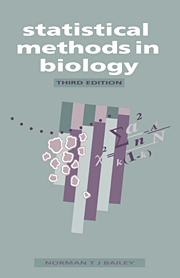Book contents
- Frontmatter
- Contents
- Preface
- 1 Introduction
- 2 Variability and frequency distributions
- 3 Estimation, standard errors and confidence limits
- 4 The basic idea of a significance test
- 5 Simple significance tests based on the normal distribution
- 6 The use of t-tests for small samples
- 7 Contingency tables and χ2
- 8 χ2-tests of goodness-of-fit and homogeneity
- 9 The correlation of measurements
- 10 Regression analysis
- 11 Simple experimental design and the analysis of variance
- 12 Introduction to factorial experiments
- 13 Random samples and random numbers
- 14 Partial correlation and multiple regression
- 15 Non-parametric and distribution-free tests
- 16 Notes on numerical calculation, calculators and computers
- Suggestions for more advanced reading
- Summary of statistical formulae
- Appendix tables
- Index
5 - Simple significance tests based on the normal distribution
Published online by Cambridge University Press: 05 June 2012
- Frontmatter
- Contents
- Preface
- 1 Introduction
- 2 Variability and frequency distributions
- 3 Estimation, standard errors and confidence limits
- 4 The basic idea of a significance test
- 5 Simple significance tests based on the normal distribution
- 6 The use of t-tests for small samples
- 7 Contingency tables and χ2
- 8 χ2-tests of goodness-of-fit and homogeneity
- 9 The correlation of measurements
- 10 Regression analysis
- 11 Simple experimental design and the analysis of variance
- 12 Introduction to factorial experiments
- 13 Random samples and random numbers
- 14 Partial correlation and multiple regression
- 15 Non-parametric and distribution-free tests
- 16 Notes on numerical calculation, calculators and computers
- Suggestions for more advanced reading
- Summary of statistical formulae
- Appendix tables
- Index
Summary
Although in the previous chapter some simple examples of significance tests were given, we were mainly concerned with the underlying ideas rather than with numerical details. We must now go on to consider more carefully the routine calculations involved in some of the situations that arise most frequently in practice. In this chapter we shall look at a number of simple tests based on the normal distribution. As mentioned before, this distribution is of very wide applicability: sometimes it will represent sufficiently well the variation of the observed measurements themselves; sometimes it can be used as a convenient approximation to other distributions such as the binomial or Poisson.
COMPARISON WITH A KNOWN STANDARD
Let us suppose that we have captured a few birds of a particular species that appear to be living on a diet that is rather different from usual. Various questions can be asked about the possible effect of a different diet on physiological function. To illustrate this we shall merely take the problem of deciding whether there seems to be any real difference in body-weight from the known average for the species.
We shall suppose for the moment that the distribution of body-weight is known fairly accurately from a large number of observations and that it is approximately normal in character. We thus know both the true mean and standard deviation to quite a high degree of precision. Let these actually be 95.61 g and 7.82 g respectively.
- Type
- Chapter
- Information
- Statistical Methods in Biology , pp. 38 - 49Publisher: Cambridge University PressPrint publication year: 1995
- 2
- Cited by

